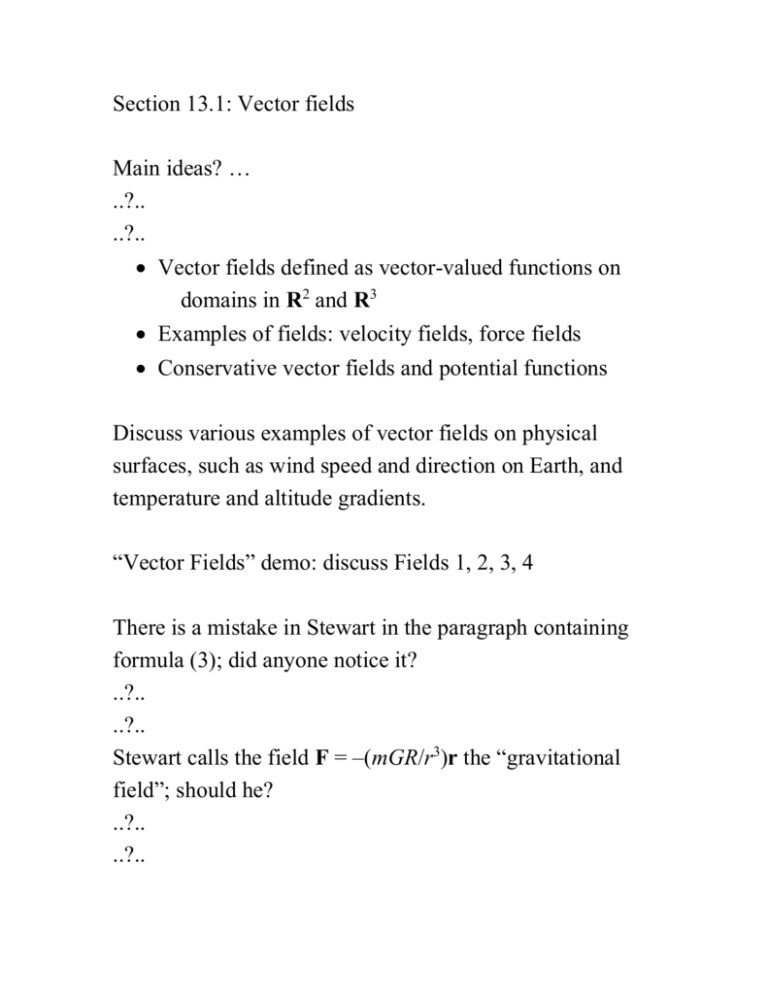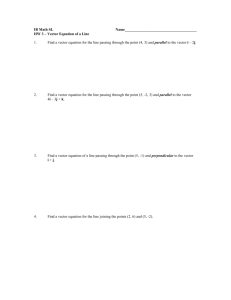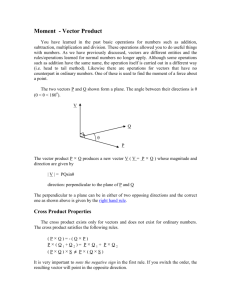Vector fields.
advertisement

Section 13.1: Vector fields
Main ideas? …
..?..
..?..
Vector fields defined as vector-valued functions on
domains in R2 and R3
Examples of fields: velocity fields, force fields
Conservative vector fields and potential functions
Discuss various examples of vector fields on physical
surfaces, such as wind speed and direction on Earth, and
temperature and altitude gradients.
“Vector Fields” demo: discuss Fields 1, 2, 3, 4
There is a mistake in Stewart in the paragraph containing
formula (3); did anyone notice it?
..?..
..?..
Stewart calls the field F = –(mGR/r3)r the “gravitational
field”; should he?
..?..
..?..
It’s customary to omit the factor of m, so that the field
represents force per unit mass. Compare this with what
Stewart says at the top of the next page where he
(correctly) defines the electric field as force per unit charge.
That is to say, physicists usually define a “gravitational
field” to be an acceleration field rather than a force field.
The gradient of a scalar field (real-valued function) f is a
vector field F; an F of the form f is called a conservative
vector field, and we call f a potential function for F.
What’s the relationship between the level sets of f and the
vector field F?
..?..
..?..
They are perpendicular.
More precisely: in R2, if f(x0,y0) = k, then F(x0,y0) is
perpendicular to the level set {(x,y): f(x,y) = k}; and in R3,
if f(x0,y0,z0) = k, then F(x0,y0,z0) is perpendicular to the level
set {(x,y,z): f(x,y,z) = k}.
Class discussion: Compute and plot f for f(x,y) = x2 + y2
and check that the vectors in the gradient field are all
orthogonal to the circles f(x,y) = k.
On pages 758–759, Stewart introduces the scalar field
f(x,y,z) = mMG/sqrt(x2+y2+z2) and its gradient F(x,y,z) =
f(x,y,z). What is the domain of the vector field F? …
..?..
..?..
{(x,y,z) in R3: (x,y,z) ≠ (0,0,0)} = R3 \ {(0,0,0)}
Does F(x,y,z) approach a limit as (x,y,z)(0,0,0)? …
..?..
..?..
That is, do the x-, y-, and z-components of F(x,y,z), namely
–mMGx/(x2+y2+z2)3/2, –mMGy/(x2+y2+z2)3/2, and
–mMGz/(x2+y2+z2)3/2, approach a limit as (x,y,z)(0,0,0)?
..?..
..?..
Try approaching the origin along a path.
..?..
..?..
All three expressions diverge as (x,y,z) approaches (0,0,0)
along the path (x,y,z)=(t,t,t).
Group Work: Sketching vector fields, 1 and 2 only (page 7
of Instructor’s Guide)











